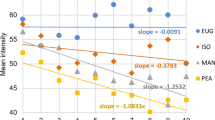Abstract
Physiological investigation of olfactory receptor function in hyposmic or anosmic patients is rare. Pioneers examined the electro-olfactogram in patients with olfactory disturbance. Although the electro-olfactogram is an established method to record olfactory responses from human olfactory epithelium, the response is only measured at specific sites of the olfactory mucosa. In contrast to that the response of the olfactory epithelium to chemosensory stimuli can be studied in a specific nasal area by means of intrinsic optical signal recording. Five functionally anosmic patients were included in the present study. In all patients, responses could be obtained following trigeminal stimulation with CO2. In some patients, responses could be obtained after olfactory stimulation with H2S and PEA. The present data show that in the studied patients trigeminal function seems to be preserved, while it appears that in some patients olfactory function is preserved to a certain degree.

Similar content being viewed by others
References
Doty RL, Brugger WE, Jurs PC, Orndorff MA, Snyder PJ, Lowry LD (1978) Intranasal trigeminal stimulation from odorous volatiles: psychometric responses from anosmic and normal humans. Physiol Behav 20:175–185
Furukawa M, Kamide M, Miwa T, Umeda R (1988) Significance of intravenous olfaction test using thiamine propyldisulfide (Alinamin) in olfactometry. Auris Nasus Larynx 15:25–31
Hummel T, Knecht M, Kobal G (1996) Peripherally obtained electrophysiological responses to olfactory stimulation in man: electro-olfactograms exhibit a smaller degree of desensitization compared with subjective intensity estimates. Brain Res 717:160–164
Hummel T, Welge-Luessen A (2008) Erfassung des Riech- und Schmeckvermoegens. In: Hummel T, Welge-Luessen A (Eds) Riech- und Schmeckstoerungen. Thieme, Stuttgart, pp 43–60
Ishimaru T (2007) Optical recording of the intrinsic signal from the human olfactory cleft. Ann Otol Rhinol Laryngol 116:335–341
Ishimaru T, Reden J, Krone F, Scheibe M (2007) Optical recordings from the human nasal mucosa in response to olfactory stimulation. Neurosci Lett 423:231–235
Ishimaru T, Scheibe M, Gudziol V, Negoias S (2008) Recordings of the optical intrinsic signal from the middle turbinate in response to olfactory and trigeminal stimulation: a pilot study. Eur Arch Otorhinolaryngol 265:781–785
Ishimaru T, Reden J, Krone F, Scheibe M (2011) Topographical differences in the sensitivity of the human nasal mucosa to olfactory and trigeminal stimuli. Neurosci Lett 493:136–139
Kent PF, Mozell MM (1992) The recording of odorant-induced mucosal activity patterns with a voltage-sensitive dye. J Neurophysiol 68:1804–1819
Kobal G, Hummel T (1992) Olfactory evoked potential activity and hedonics. In: Van TS, Dodd GH (eds) Fragrance: the psychology and biology of perfume. Elsevier Applied Science, London, pp 175–194
Kobal G, Klimek L, Wolfensberger M, Gudziol H, Temmel A, Owen CM, Seeber H, Pauli E, Hummel T 2000 Multicenter investigation of 1,036 subjects using a standardized method for the assessment of olfactory function combining tests of odor identification, odor discrimination, and olfactory thresholds. Eur Arch Otorhinolaryngol 257:205–211
Kobal G 2003 Electrophysiological measurement of olfactory function. In: Doty RL (ed) Handbook of olfaction and gustation, 2nd edn. Marcel Dekker, New York, pp 229–249
Leopold DA, Hummel T, Schwob JE, Hong SC, Knecht M, Kobal G (2000) Anterior distribution of human olfactory epithelium. Laryngoscope 110:417–421
Mackay-Sim A, Kesteven S (1994) Topographic patterns of responsiveness to odorants in the rat olfactory epithelium. J Neurophysiol 71:150–160
Miwa T, Moriizumi T, Horikawa I, Uramoto N, Ishimaru T, Nishimura T, Furukawa M (2002) Role of nerve growth factor in the olfactory system. Microsc Res Tech 58:197–203
Takagi SF 1989 A standardized venous olfactory test. In: Takagi SF (ed) Human olfaction, University of Tokyo Press, Tokyo, pp 56–58
Yamagishi M, Okazoe R, Ishizuka Y (1994) Olfactory mucosa of patients with olfactory disturbance following head trauma. Ann Otol Rhinol Laryngol 103:279–284
Conflict of interest
None of the authors declared a financial interest in the current experiments.
Author information
Authors and Affiliations
Corresponding author
Rights and permissions
About this article
Cite this article
Ishimaru, T., Krone, F., Scheibe, M. et al. Intrinsic chemosensory signal recorded from the human nasal mucosa in patients with smell loss. Eur Arch Otorhinolaryngol 270, 1335–1338 (2013). https://doi.org/10.1007/s00405-012-2203-4
Received:
Accepted:
Published:
Issue Date:
DOI: https://doi.org/10.1007/s00405-012-2203-4




